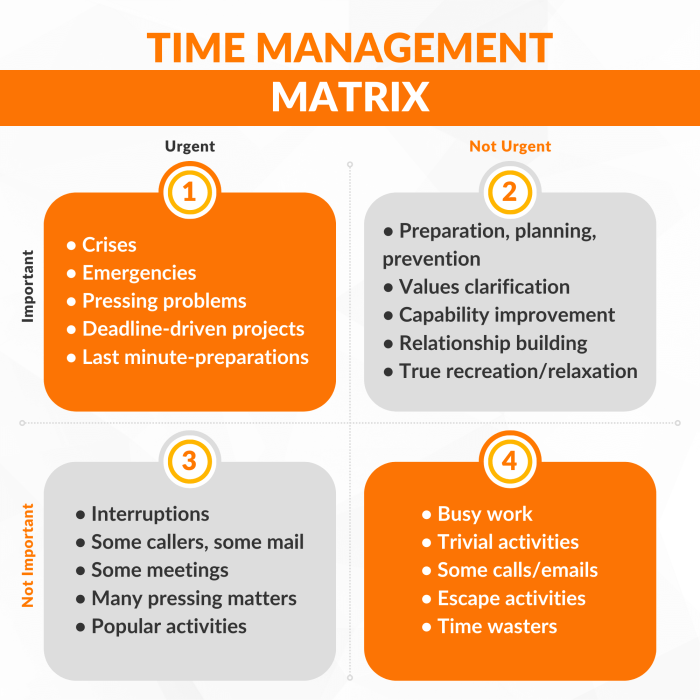How to Learn 15 Useful Time Management Tips is a comprehensive guide to mastering your time effectively. Dive into the world of efficient time management techniques that can transform your daily routine and boost your productivity. From setting clear goals to avoiding multitasking, this article covers it all.
Introduction to Time Management Tips

Time management is the process of planning and organizing how to divide your time between specific activities. It involves setting goals, prioritizing tasks, and using resources efficiently to achieve those goals.
Effective time management is crucial in daily life as it helps individuals make the most out of their day, ensuring that tasks are completed in a timely manner. When time is managed well, productivity increases, stress levels decrease, and individuals have more time for leisure activities or relaxation.
Examples of Positive Impact of Good Time Management
- Increased productivity: By prioritizing tasks and allocating time efficiently, individuals can accomplish more in less time.
- Reduced stress: Proper time management reduces the feeling of being overwhelmed, as tasks are tackled systematically and deadlines are met with ease.
- Improved work-life balance: With effective time management, individuals can allocate time for work, family, hobbies, and self-care, leading to a more fulfilling and balanced life.
Setting Clear Goals

Setting clear and achievable goals is crucial for effective time management. When you have a clear vision of what you want to accomplish, it becomes easier to prioritize tasks and allocate your time wisely.Goal setting helps in prioritizing tasks by giving you a roadmap to follow. You can identify which tasks are urgent, which ones are important, and which ones can be delegated or eliminated.
This way, you can focus your time and energy on activities that align with your goals and bring you closer to achieving them.
Short-term and Long-term Goals
- Short-term Goal: Completing a project ahead of schedule to improve time management skills.
- Long-term Goal: Developing a daily routine that includes time for work, exercise, and relaxation to maintain a healthy work-life balance.
Prioritizing Tasks
When it comes to effective time management, prioritizing tasks based on urgency and importance is key. By focusing on what needs to be done first, you can maximize your productivity and ensure that nothing important gets overlooked.
Techniques for Prioritizing Tasks
- Use the Eisenhower Matrix: This method categorizes tasks into four quadrants based on urgency and importance. Tasks are then prioritized accordingly.
- Consider deadlines: Tasks with looming deadlines should be given higher priority to ensure they are completed on time.
- Assess impact: Determine the potential impact of each task on your goals or projects to prioritize those that will make the biggest difference.
Handling Multiple Tasks Efficiently
- Break tasks into smaller steps: This makes it easier to focus on one aspect at a time and progress efficiently.
- Use time blocking: Allocate specific time slots for different tasks to maintain focus and avoid multitasking.
- Prioritize based on energy levels: Tackle more demanding tasks when you have the most energy and focus.
Benefits of Prioritizing Tasks
Prioritizing tasks can lead to better time management by ensuring that important tasks are completed first and unnecessary time is not wasted on less critical activities. By focusing on what truly matters, you can increase productivity and achieve your goals more effectively.
Creating a Schedule
Creating a schedule is a crucial aspect of effective time management. It helps you stay organized, focused, and productive throughout the day or week.
The Benefits of Creating a Daily or Weekly Schedule
- Allows you to allocate time for important tasks and activities.
- Helps in avoiding procrastination by setting specific time slots for each task.
- Improves efficiency by providing a clear roadmap of what needs to be done.
- Reduces stress and overwhelm by breaking down tasks into manageable chunks.
Different Methods for Scheduling Tasks
- Using Digital Tools: Utilize apps like Google Calendar, Trello, or Todoist for easy access and reminders.
- Traditional Planners: Opt for physical planners or journals to jot down tasks and appointments.
- Combination Approach: Combine digital tools with traditional methods for a hybrid scheduling system.
Tips on How to Stick to a Schedule
- Set realistic time frames for each task to avoid overloading your schedule.
- Prioritize tasks based on importance and deadlines to ensure critical items are completed first.
- Stay flexible and be open to adjusting your schedule as unexpected events or priorities arise.
- Review and reassess your schedule regularly to make necessary tweaks for better efficiency.
Time Blocking

Time blocking is a time management technique that involves dividing your day into blocks of time dedicated to specific tasks or activities. By allocating a set amount of time to each task, you can focus on one thing at a time and avoid distractions, leading to increased productivity and efficiency.
Importance of Time Blocking
Time blocking helps you prioritize tasks, stay organized, and make the most out of your day. By setting aside dedicated time for each activity, you can ensure that important tasks are completed on time and avoid feeling overwhelmed by a long to-do list.
- By scheduling specific blocks of time for different tasks, you can focus on one task at a time without multitasking, which can lead to decreased productivity.
- Time blocking can help you estimate how long each task will take, allowing you to allocate the appropriate amount of time and avoid overcommitting to unrealistic deadlines.
- It also helps you identify time-wasting activities and eliminate them from your schedule, leading to better time management and improved efficiency.
Implementing Time Blocking
To implement time blocking in your daily routine, follow these tips:
- Start by identifying your most important tasks and setting clear goals for each day.
- Allocate specific blocks of time for each task based on its priority and complexity.
- Use a calendar or planner to schedule your time blocks and stick to the predetermined schedule.
- Avoid distractions during each time block by turning off notifications and focusing solely on the task at hand.
- Regularly review and adjust your time blocks as needed to accommodate changing priorities or unexpected events.
Avoiding Multitasking

Multitasking is often seen as a way to get more done in a shorter amount of time, but in reality, it can have negative effects on productivity. When we try to juggle multiple tasks at once, our focus becomes divided, leading to decreased efficiency and quality of work.Focusing on one task at a time has been proven to be more effective in completing tasks efficiently and accurately.
By giving your full attention to one task, you can fully engage with the work at hand and produce better results.
The Drawbacks of Multitasking
- Mistakes are more likely to occur when attention is divided.
- It takes longer to complete each task when switching back and forth.
- Quality of work may suffer due to lack of focus.
Benefits of Focusing on One Task at a Time
- Increased productivity and efficiency in completing tasks.
- Improved quality of work with undivided attention.
- Reduced stress and overwhelm by focusing on one thing at a time.
Tips to Avoid Multitasking and Stay Focused
- Prioritize tasks and focus on one task at a time.
- Set specific time blocks for each task to maintain focus.
- Avoid distractions by turning off notifications and setting boundaries.
- Practice mindfulness to stay present and focused on the task at hand.
- Take regular breaks to recharge and maintain focus throughout the day.
Delegating Tasks
Delegating tasks is a crucial aspect of effective time management as it allows you to distribute workload efficiently, focus on high-priority tasks, and optimize productivity. By assigning tasks to others, you can free up valuable time to concentrate on tasks that require your expertise and attention.
Identifying Tasks for Delegation
- Tasks that are repetitive and do not require specific skills or knowledge can often be delegated. These tasks can include data entry, basic research, or administrative duties.
- Tasks that are time-consuming but do not contribute directly to your core responsibilities can also be candidates for delegation. This can include organizing meetings, responding to routine emails, or managing paperwork.
- Tasks that fall outside your area of expertise or are better suited for someone else on your team should be considered for delegation. By leveraging the strengths of others, you can ensure tasks are completed more efficiently.
Benefits of Delegating Tasks
- Delegating tasks allows you to focus on high-priority activities that require your expertise, leading to better outcomes and increased productivity.
- By distributing workload among team members, you can ensure tasks are completed in a timely manner, improving overall efficiency and meeting deadlines effectively.
- Delegating tasks fosters a sense of teamwork and collaboration within the team, promoting a positive work environment and enhancing morale.
Minimizing Distractions
Distractions can significantly impact our ability to manage time effectively, leading to decreased productivity and efficiency. Common distractions in the workplace or study environment include social media notifications, noisy colleagues, email alerts, and personal phone calls. To improve time management skills, it is crucial to minimize these distractions and create a focused work environment.
Strategies for Minimizing Distractions
- Avoid keeping your phone within reach or turn off notifications to limit interruptions.
- Use noise-canceling headphones to block out background noise and stay focused on tasks.
- Schedule specific times to check emails or messages instead of responding immediately to every notification.
- Organize your workspace to reduce clutter and create a clean, distraction-free zone.
Taking Breaks
Regular breaks play a crucial role in maintaining focus and productivity during work or study sessions. They allow our minds and bodies to recharge, helping us avoid burnout and stay efficient throughout the day.
Benefits of Taking Breaks, How to Learn 15 Useful Time Management Tips
- Enhanced focus: Breaks help prevent mental fatigue, allowing us to return to tasks with renewed concentration.
- Increased productivity: Short breaks can boost overall productivity by giving us a chance to rest and reset our minds.
- Improved creativity: Stepping away from work for a brief period can stimulate creativity and fresh ideas.
- Reduced stress: Breaks provide a moment of relaxation, reducing stress levels and promoting overall well-being.
Tips for Effective Break Scheduling
- Schedule regular breaks: Plan short breaks throughout the day to maintain energy and focus.
- Use the Pomodoro technique: Work in focused intervals followed by short breaks to maximize productivity.
- Engage in physical activity: Take a quick walk or do some stretching during breaks to refresh your body and mind.
- Avoid screen time: Use break time to disconnect from screens and give your eyes and mind a rest.
Reviewing Progress
Reviewing progress towards goals is crucial in effective time management. It allows individuals to track their performance, identify areas for improvement, and make necessary adjustments to their strategies. By regularly reviewing progress, individuals can ensure they are on the right track and staying focused on their objectives.
Techniques for Tracking and Evaluating Time Management Practices
- Utilize a time tracking tool or app to monitor how time is spent on different tasks throughout the day.
- Keep a daily journal or log to record accomplishments, challenges faced, and areas where time could be better utilized.
- Conduct weekly or monthly evaluations to assess the effectiveness of time management techniques implemented.
Examples of Regular Progress Reviews Leading to Improvement
- After reviewing progress, an individual realizes they are spending too much time on low-priority tasks. By adjusting their schedule and focusing more on important tasks, they see a significant improvement in productivity.
- Through regular progress reviews, an individual identifies time-wasting habits and implements strategies to eliminate them. This leads to better time management and increased efficiency in completing tasks.
Time Management Tools
When it comes to managing your time effectively, using the right tools can make a significant difference in your productivity. There are various tools and apps available that can help you organize your tasks, schedule your time, and stay focused on your goals.
Comparison of Time Management Tools
- Task Management Apps: Tools like Todoist, Trello, and Asana help you create to-do lists, set deadlines, and track your progress on tasks.
- Calendar Apps: Platforms such as Google Calendar, Apple Calendar, and Microsoft Outlook can help you schedule your appointments, meetings, and events efficiently.
- Time Tracking Software: Apps like Toggl, RescueTime, and Clockify allow you to monitor how you spend your time and identify areas where you can improve your efficiency.
- Pomodoro Technique Apps: Tools such as Focus Booster, Pomodone, and TomatoTimer help you break your work into focused intervals with short breaks in between to enhance productivity.
It’s essential to choose time management tools that align with your workflow and preferences to maximize their effectiveness.
Mindfulness and Time Management: How To Learn 15 Useful Time Management Tips
Mindfulness practices play a crucial role in effective time management by helping individuals stay focused, reduce stress, and increase productivity.
Benefits of Mindfulness in Time Management
- Mindfulness techniques can reduce stress levels, allowing individuals to approach tasks with a clear mind and improved focus.
- By practicing mindfulness, individuals can enhance their ability to prioritize tasks effectively and make better decisions regarding time allocation.
- Being mindful helps in avoiding distractions and staying present in the moment, leading to increased efficiency in completing tasks.
Incorporating Mindfulness into Daily Routine
- Start the day with a brief mindfulness meditation to set a positive tone for the day ahead.
- Practice deep breathing exercises throughout the day to stay calm and focused during challenging tasks.
- Take short mindfulness breaks between tasks to reset your mind and maintain productivity levels.
Developing a Routine

Establishing a daily routine can bring numerous benefits to your time management skills. By following a structured routine, you can create a sense of stability, reduce decision fatigue, increase efficiency, and improve productivity.
Tips for Creating a Structured Routine
- Start by identifying your most important tasks and setting specific time blocks for them in your schedule.
- Allocate time for activities such as planning, breaks, and reviewing progress to ensure a well-rounded routine.
- Stick to your routine consistently to establish a habit and make the most out of your time.
Examples of Enhancing Productivity with a Consistent Routine
- Waking up at the same time every day can help regulate your body clock, leading to better focus and energy throughout the day.
- Having a designated time for exercise in your routine can boost your physical and mental well-being, enhancing overall productivity.
- Scheduling regular breaks between tasks can prevent burnout and keep your mind fresh for optimal performance.
Learning to Say No
Setting boundaries and learning to say no are crucial aspects of effective time management. By politely declining tasks that do not align with our goals, we can focus on what truly matters and avoid wasting time on less important activities. Here are some tips on how to say no effectively and examples of how it can help in prioritizing tasks.
Importance of Setting Boundaries
- Avoid overcommitting by setting clear boundaries on what tasks you can take on.
- Focus on tasks that align with your goals and values to ensure your time is well spent.
- Saying no to tasks that do not contribute to your overall objectives can lead to better time management.
Tips for Politely Declining Tasks
- Express gratitude for the opportunity but politely decline if the task does not align with your current priorities.
- Provide a brief explanation of why you are unable to take on the task at the moment.
- Suggest an alternative solution or offer to help at a later time if possible.
Examples of How Saying No Helps Prioritize Tasks
- By declining tasks that do not align with your goals, you free up time to focus on high-priority activities.
- Saying no to additional commitments allows you to dedicate more time and energy to tasks that are essential for your success.
- Prioritizing tasks effectively becomes easier when you learn to say no to distractions and unimportant requests.
Continuous Improvement
Continuous improvement is a key aspect of mastering time management skills. By consistently evaluating and refining your approach to managing time, you can enhance your efficiency and productivity over time.
Importance of Learning from Past Experiences
- Reflect on past time management successes and failures to identify what worked well and what could be improved.
- Use past experiences as learning opportunities to fine-tune your strategies and approaches.
- Adjust your time management practices based on insights gained from previous experiences.
Tips for Continuous Refinement of Time Management Practices
- Regularly assess your current time management methods to identify areas for improvement.
- Seek feedback from others to gain different perspectives on your time management habits.
- Experiment with new techniques and tools to optimize your time management efficiency.
- Track your progress and results to measure the impact of changes and adjustments.
- Stay open to new ideas and strategies that can help you further enhance your time management skills.
Outcome Summary
In conclusion, mastering these 15 time management tips can lead to a more organized and efficient lifestyle. By implementing these strategies into your daily routine, you can achieve your goals with ease and reduce stress along the way. Start your journey to better time management today!